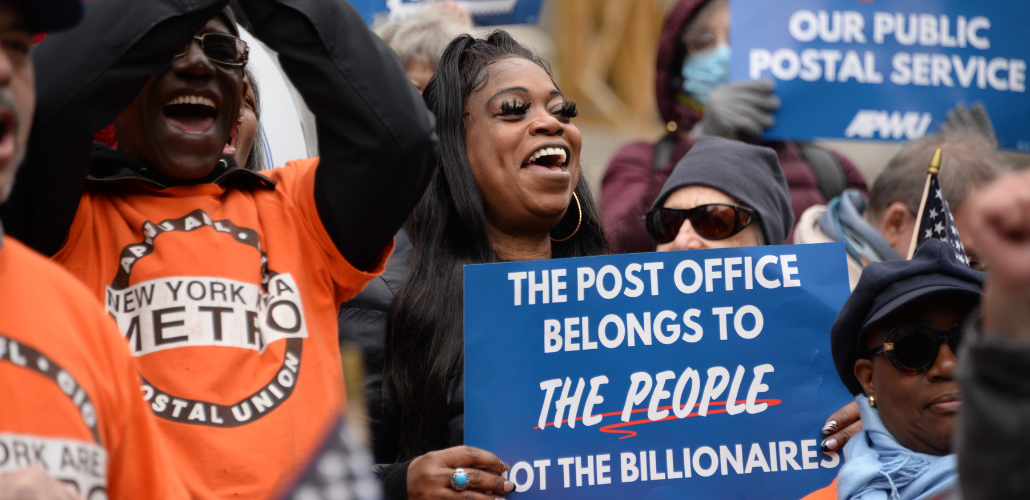Postal Workers Throng to 500 Rallies to Save the Postal Service

“Whose Postal Service?” workers chanted in New York City: “The people’s Postal Service.” Photo: Jenny Brown. See more photos here.
From big cities to small towns, postal workers organized hundreds of rallies across the country in the past week to defend a beloved public service—and the nation’s largest union employer—against privatization and DOGE attack.
“Whose Postal Service?” workers chanted in New York: “The people’s Postal Service.”
“U.S. Mail Is Not for Sale” was the rallying cry March 20 at 250 rallies organized by the Postal Workers (APWU). “Fight Like Hell” was the theme March 23 for another 210 rallies led by the Letter Carriers (NALC).
A hundred people came out to the NALC rally in St. Petersburg, Florida, covering all four corners of the busiest intersection in town, said Roger Ezra Butterfield, a recently minted steward in APWU.
“I’ve been going to pickets for about 15 years, for farmworkers, for nurses, but I’ve never seen such a positive reception,” Butterfield said. “The ratio of getting flipped off to getting cheered on was heavily in our favor. There was so much honking, people shouting ‘We love postal workers!’ It was incredibly exciting.”
A hundred and twenty showed up for the APWU rally in Des Moines, Iowa, said letter carrier Margo O’Neill. “We were fired up,” she said. “More than anything I was glad to have the chance to express solidarity with APWU. I’m glad we can start working together.” Mail handlers and rural carriers came too: all four major postal service unions were represented.
BOTTOM-UP PLANNING
The NALC’s “Fight Like Hell” events were originally meant to be contract rallies, after letter carriers voted down a pitiful contract offer in January.
It was a breakthrough for the union’s bottom-up reform movement when NALC leadership agreed to call a national day of action. After a couple zigs and zags, the national even got on board with the date backed by the Build a Fighting NALC caucus—a Sunday, when most members are off work.
An energetic demonstration in Detroit, possibly the first that NALC Branch 1 has ever organized, drew 300 enthusiastic letter carriers and family members. “This is my first rally—and it won't be my last,” one worker told longtime Labor Notes editor Jane Slaughter, who called it the most encouraging rally she had been to since Trump took office.
Three hundred turned out in the pouring rain in Seattle, where speakers included a federal worker from the Environmental Protection Agency and a veteran of the 1970 postal strike.
DOWNSIZE AND PRIVATIZE?
Foreboding clouds have hung over USPS since the reelection of Trump, who during his first term made no secret of his ambitions to downsize and privatize the service. His Postal Board of Governors back then appointed as Postmaster General Louis DeJoy, a major Trump campaign fundraiser from the private logistics sector.
While protests have stalled some parts of DeJoy’s 10-year plan of drastic cost-cutting and reorganization, he has managed to enact others, and until recently vowed he wasn’t going anywhere. But in February he announced he would be leaving, though he didn’t set a date.
Days later the Washington Post broke the news that Trump was on the verge of signing an executive order to bring the currently independent USPS under the Commerce Department, an illegal move that would presumably curtail union rights. Unlike other federal workers, postal workers since their 1970 strike have enjoyed full collective bargaining rights and the protections of the National Labor Relations Act.
The executive order still hasn’t arrived—but the threat set many dominos tumbling. The Postal Board of Governors held an emergency meeting and hired its own lawyers. DeJoy opened the door and invited DOGE in to help him hack away at specific parts of USPS, including workers’ retirement and a regulatory commission he doesn’t like. Wells Fargo investment analysts put out a memo drooling over postal privatization opportunities.
And the NALC leadership rushed the economic part of the contract into expedited arbitration, abandoned noneconomic issues, and refocused its “Fight Like Hell” rallies to emphasize the new threats.
CONTRACT FALLOUT
The day after the rallies, March 24, NALC President Brian Renfroe announced that the arbitrator had awarded a deal on March 21. The raises are barely improved—where the rejected offer had raises of 1.3 percent each year, the forced-upon-members contract has 1.3 percent the first year, 1.4 the second, and 1.5 the third.
Letter carriers, fresh off the energy of their rallies, were furious.
“It’s functionally the same contract that we all just voted down,” said O’Neill. She thought Renfroe might have trouble winning his next election after this. “One thing that rang true in a lot of people’s minds immediately is that UPS with [Teamsters then-President] James Hoffa Jr., he forced through that contract that they had voted down [in 2018] and then he ended up getting voted out.”

SUPPORT LABOR NOTES
BECOME A MONTHLY DONOR
Give $10 a month or more and get our "Fight the Boss, Build the Union" T-shirt.
She has been helping build a local chapter of the Build a Fighting NALC caucus. “We have made so many connections with letter carriers across the state,” she said, giving as an example the town of Ames, which turned out 50-60 people for the NALC rally—impressive for a branch with just 30 members. People in rural communities, whatever their politics, rely on the postal service.
“It’s really heartening to see people standing up and see resistance even in these small pockets of Iowa,” O’Neill said. “I know there are a lot of people out there who are really upset with the union and just want to leave the union. We’re offering an alternative and saying, ‘Don’t leave the union. We need all hands on deck to make it better—either push leadership to take our side or find a new leadership.’”
In Seattle, “the members of Branch 79 that showed up, showed that they cared to fight and cared to win, and they had the gumption to win,” said letter carrier C. Moline. “Brian Renfroe has shown time and time again that he doesn’t have that, and that’s why he should step down. But he won’t step down, and that’s why we’re going to have to take him down.
“All the pride I feel about our rally is about equal to all the shame I feel about this man.”
The union election is next year. Two candidates have been gathering steam to challenge Renfroe for the presidency. And bargaining has taken so long that the NALC will be back at the table at next year, too. This contract is retroactive to 2023 and expires in 2026.
WOLF AT THE DOOR
A national day of action is not so novel in the APWU. Members rally regularly, most recently last fall when bargaining kicked off. But turnout was higher this time: at least double, for instance, in Tampa.
“There’s a feeling in the air that something is different,” said Butterfield. Local union leaders have been projecting urgency: texting members, asking stewards to talk about the threat, holding town halls on all three shifts in the distribution plant. Still, there’s also skepticism: people say “I’ve been hearing about privatization my entire career, and it hasn’t happened yet.”
“The boy who cried wolf metaphor been raised,” Butterfield said. “Our local president is saying this is very different: the wolf is at the door.”
The Wells Fargo memo bluntly suggests mass layoffs, doubling postal prices, selling off half the post offices, and eliminating the central mandate that USPS must provide universal service at universal rates. “You can send a postcard from rural Alaska to Tampa, Florida, for less than a dollar,” Butterfield said.
The APWU is still in bargaining, working under an extension of its recently expired contract. At last summer’s convention, members passed a resolution that the union should answer the United Auto Workers’ call to line up contract expirations around May Day 2028; this would be the contract in which to get that done.
The Rural Carriers (NRLCA) also rallied March 24 in Washington, D.C.
FOX ENTERS HENHOUSE
Contrary to what he had said about sticking around to make a smooth transition to his replacement, Postmaster General DeJoy announced his immediate resignation on March 24. Washington Post reporting suggested he was pushed out for not giving DOGE complete access.
“He let the fox into the henhouse and said, ‘Why don’t you just do the dishes,’” Moline said. “That’s not how this works.”
Meanwhile the administration’s attacks on workers in the rest of the federal sector are reaching a fever pitch. The latest executive order, issued March 27, is meant to eliminate the limited collective bargaining rights that federal workers have had. Four current bills in the House would dismantle additional union rights, like dues deduction and paid time for stewards.
“Forcing our representatives to go on record opposing legislation like that would be a good step,” said O’Neill. “The most important thing is that we organize, talk to the people we work with, discuss what privatization would mean for us—for the city letter carrier, and for our families that don’t live in cities.”
“While [Trump] has us looking at policies of hate and discrimination and prejudice, what he’s doing is he’s distracting us from the real picture,” said New York Metro Area APWU President Jonathan Smith at the March 20 rally. “And the real picture is corporate greed.
“Do not ever believe that this fight is about white versus black. It’s about rich versus poor. It’s about the haves and the have-nots… Who built this country? It wasn’t people in suits. It was people in coveralls.”
Jane Slaughter and Jenny Brown contributed reporting.




